The Hot Wheels id Sub-brand is a brilliant way to increase value to the customers and profits for Mattel.
Many brands today are trying to offer premium products under a sub-brand because their main product is associated with being inexpensive or has been commoditized by the market.
Established brands introduce a new product at a higher price, market it under a sub-brand to separate it from what came before, and hope that the customers see the value in the new product. The premium sub-brand offers a path to increase profits when the main product might be headed towards being a net loss.
For example, McDonald’s business objective is to increase profitability. Their core offerings (the Big Mac, Chicken McNuggets, etc.) are known for being cheap. With labor costs on the rise, so in the future, McDonald’s would lose money every time they sold a meal.
They could just hike their prices, but this would stop customers from coming because inexpensive food was part of the McDonald’s brand. Instead, they are reshaping the brand by offering premium products with high-profit margins under sub-brands like McCafe.
Mattel is using a similar tactic, but with far more innovation than combining coffee and milk in different ways. Hot Wheels id offers premium cars and tracks with technology that take the fun of Hot Wheels cars to another level.
In return, Mattel gets to sell cars at 6X the price point and much more profitably. Hot Wheels also expands the visibility of the Mattel sub-brand by selling in premium channels like Apple.com, a place they would never have sold their original cars. They also access customers through the App Store, retail, and the press that comes with offering something different.
Every aspect of Hot Wheels id makes the project sounds like a win-win-win to me. I appreciate both the product and the business strategy so much that I had to tell you about it.
What is Hot Wheels id?
Hot Wheels id cars are similar to the standard cars, but with an RFID chip that connects them to a phone or tablet.
Hot Wheels id is a sub-brand of Hot Wheels and is owned and managed by Mattel.
The Hot Wheels id product line consists of four main products.
App
| Product Category | Mobile Game |
| Product Name | Hot Wheels id |
| Price | Free |
The Hot Wheels id app is available for free on the Google Play Store and the Apple App Store. The app can be downloaded and played with for free, but it is the most fun when the users have some Hot Wheels id cars. Studio Gobo develops the app.
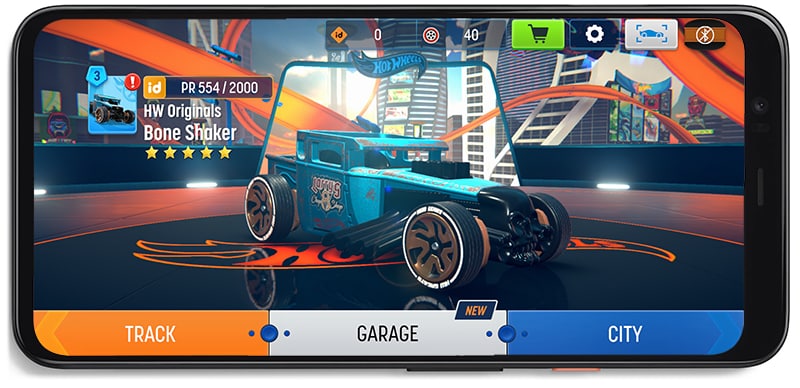
Toy Cars
| Product Category | Toy Cars |
| Product Name | Hot Wheels id Rodger Dodger, Hot Wheels id Tesla Model S, etc. |
| Price | $3.15 to $6.99 (USD) |
Hot Wheels id cars are the same size, scale (1:64), and construction as standard Hot Wheels cars. They have an RFID chip mounted to the base of the vehicle that can connect them to the app by being scanned either by a phone or tablet or the Hot Wheels id Portal.
There are nine classes of cars:
- Speed Demons: Licensed sports and exotic cars with original graphics.
- Street Beasts: Original designs based on creatures like sharks and spiders.
- Factory Fresh: Licensed cars that look like production cars.
- Hot Wheels Icons: Classic Hot Wheels cars redone as id cars
- Hot Wheels Race Team: Licensed and original designs that look like race cars.
- Hot Wheels Metro: Original sedans and trucks.
- Hot Wheels Batman: Batmobiles from various movies, cartoons, and video games.
- Hot Wheels Screen Time: Licensed cars from TV shows and movies.
- Hot Wheels Night Burners: Original car designs with flame graphics.
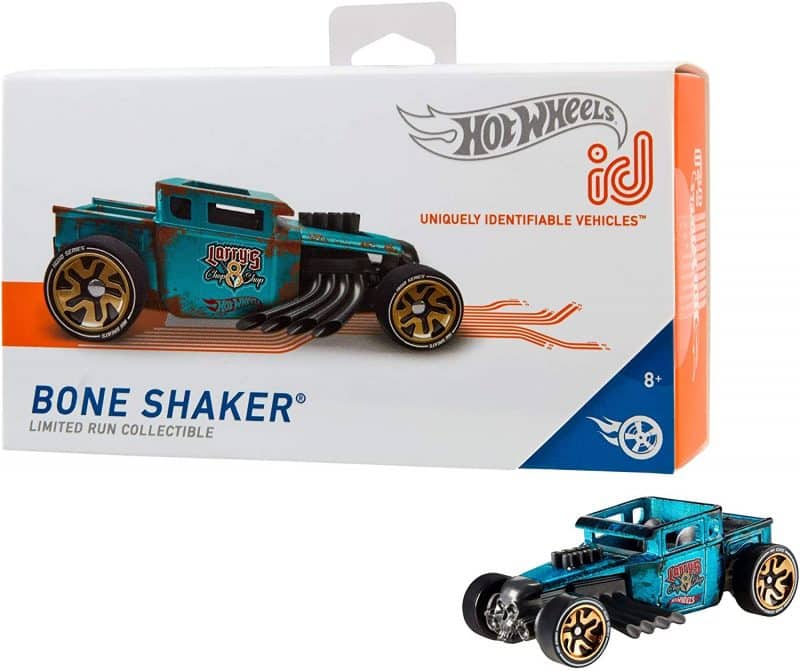
Toy Portal
| Product Category | Construction Toy |
| Product Name | Hot Wheels id Race Portal |
| Price | $27.44 (USD) |
The Hot Wheels id Race Portal is a straight section of track that sends information about the cars passing through to the app. It connects to the standard Hot Wheels tracks. The portal has an RFID chip scanner that can read information about the vehicle, including its speed. The sends the data to a phone or tablet through a Bluetooth wireless connection.
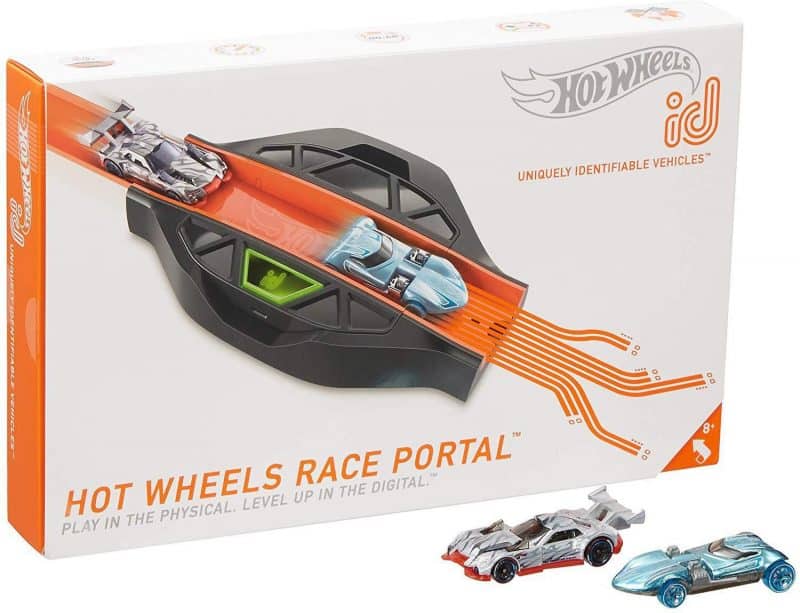
Toy Track Set
| Product Category | Construction Toy |
| Product Name | Hot Wheels id Smart Track |
| Price | $170.99 (USD) |
The Hot Wheels id Smart Track is a set of tracks that can make circuits of many different configurations. It includes the portal (same as above), which sends the car information and speed to the app via Bluetooth via a phone or tablet. It also contains two banked turns, a loop-d-loop, and a booster you pump with your hand. The app can read what configuration the track is set up as. It is not backward compatible with other Hot Wheels tracks; this track is a higher quality design.
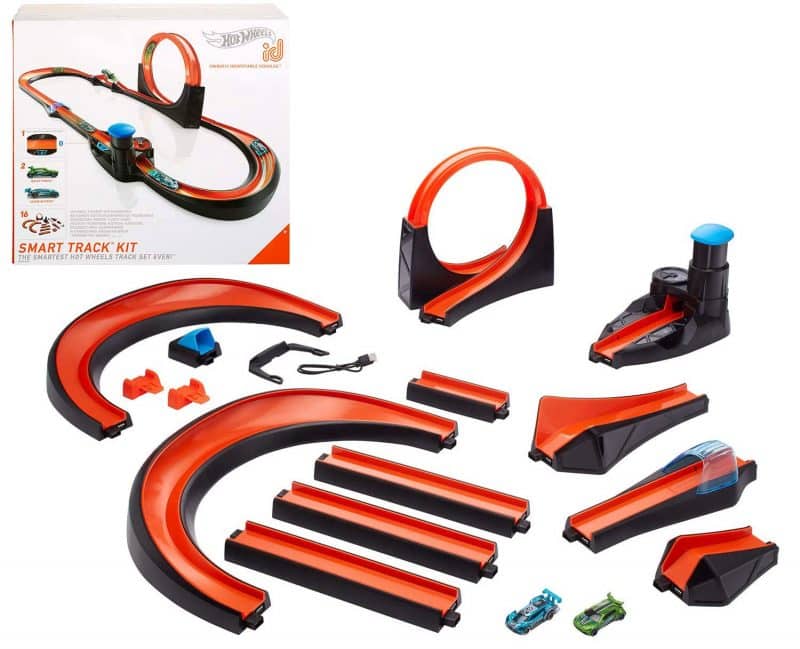
The Store Behind Hot Wheels id
Okay… toys and an app? What’s the big deal?
Hot Wheels id is a very sophisticated business initiative that solves a real problem for Mattel. Learning about it will help you design programs to solve problems your business faces or will face as the market changes.
Let’s get into it:
Failure to Launch
If was an uphill battle for the Hot Wheels NFC project with internal fighting, but a surprise visit from Apple changed everything.
Since 2015, Mattel was considering putting NFC chips into toys. Nintendo had great success with their Amiibo line of figurines with NFC chips that unlocked in-game characters, and Activision saw similar success with Skylanders.
But Mattel didn’t like how the figures were little more than the key to unlock something in the game. Kids did not play with the Amiibo or Skylander figures at all after unlocking the in-game content.
In 2016, Mattel started playing with the idea of adding NFC chips into Hot Wheels cars. But they got stuck on what digital experience would boost the experience of the vehicle and vice versa.
They contracted with IDEO, a research and design consultancy, to study how and why kids were playing with their existing Hot Wheels. They learned that the key to digital experiences was a constant rise in the challenge of the game. Toys with crappy, one level mini-games that came with a toy didn’t interest kids over the professional video games with mounting difficulty.

In 2017, Apple came for a unique visit to Mattel’s headquarters in LA Mattel showed them several tech initiatives they had in the pipeline.
“We showed them ideas across the entire Mattel portfolio. Monster High. Barbie. Whatever,” Chris Down, Mattel’s Chief Design Officer, told Fast Company. “The last slide of the presentation deck was just labeled ‘NFC smart cars.’ It was the one thing Apple leaned forward to and wanted to know more about.”
The representatives from Apple knew that they were going to open up the NFC reader in all iPhones (7 and later) to third party apps. Previously, NFC was only available to the Apple Pay app.
Mattel decided 2018 was the year to launch Hot Wheels cars with NFC chips; 2018 was the 50th anniversary of the Hot Wheels brand.
But Hot Wheels id didn’t launch until 2019. Internal in-fighting delayed the project; the Hot Wheels NFC project got off track because the business and marketing teams inside Mattel fought it. Chris Down saw this as a good sign; if people thought what they were doing was so compelling that it might threaten the legacy toy car business, then they may be onto something.
Chris Down bypassed business and marketing by sending Ron Friedman, then a Senior Product Manager, to Product School to understand software product management. He needed someone who understood software products enough to put together a business plan and put it on the Chief Financial Officer’s desk. The CFO approved it, and that business plan became the basis of Hot Wheels id.
Mattel has a Big Problem.
Kids aren’t playing with toys. Screens take more and more of their time until it’s all they play with.
“You kids these days only care about your tablets and cell phones. Back in my day, we played with toys!”
Too much screen time is such a stereotypical complaint from older folks that it is almost comical. But there is truth to it.
Kids are playing on screens more and more until they are teens when they (nearly) exclusively play on their phones, tablets, or computers. By age 8, children are spending as much time with screens as physical toys. By age 11 or 12, pre-teens are playing almost exclusively using their screens.
This trend presents a large business problem for Mattel.
Mattel can and does bring their brands like Hot Wheels, Barbie and Fisher-Price into video games, but selling bits on screens is far less lucrative and far more challenging than selling plastic and metal toys.
When selling apps, the competition is high, and the customer value is low. Mattel has to compete with the thousands of games on the app stores, but they also have to compete for attention with social media apps. And customers do not spend much on apps because they are commoditized; it only takes someone buying 5 or 10 Hot Wheels cars before Mattel has made more from a customer than they ever would on an app. The average American household has over 50 Hot Wheels.
Gatekeeping Parents
Kids may be the ones playing with Hot Wheels, but parents buy them.
Something to understand that will make Mattel’s decision regarding Hot Wheels id is that their customer is two people: parents and children.
(We’ll put aside adult Hot Wheels collectors for the moment.)
You could falsely assume that the market for Hot Wheels is kids because they are the ones receiving the value. But it is parents who are paying, and they have their own needs and objectives.
Scenarios where the buyer is not receiving the value directly are quite common. Insurance companies pay for medical procedures that beneficiaries receive the value. Retailers pay for products, but their shoppers receive the value. Insurance companies, retailers, and all buyers want to see value for themselves as well as the person they are taking care of.

With the toy market, parents are gatekeepers. Parents mentally commit to spending a certain amount of money on what their kids want, but on what items depends on their values as parents. They may not know what their kids want, but they know what they will object to.
I learned this when I worked with Kraft on the product development of Jell-O several years ago. Fruit snacks made with “real fruit” were taking market share over other snacks, like Jello, which was perceived to be more processed. Parents increasingly felt like “bad moms” or “bad dads” if they bought processed snacks for their kids. While kids never stopped liking Jell-O, parents were veto-ing it in store.
With Hot Wheels id, the value parents hold dear is limiting “tech time.” (It’s an ongoing struggle with my son.) Parents feel bad when their kids are playing on screens for more than a couple of hours a day. They feel neglectful and that their kids are missing out. Parents are increasingly casting their veto against phones, tablets, computers, and video games.
But doesn’t Hot Wheels id push kids to tablets and video games? It is easy to assume that Mattel is blind to the market at first blush, but that is why the initiative is so sophisticated.
Just as sugary snacks bypass the parent’s veto by being “made with real fruit,” Hot Wheels id avoid the parent’s veto by being “mixed play.”
Hot Wheels id requires kids to physically play, meaning parents can feel good about the purchase. Kids get to play what is essentially a video game, and parents get to feel good that their kids are physically playing. Everyone wins.
(Don’t tell parents that there are games on the Hot Wheels id app that don’t require physical play!)
Learning from video games rather than dismissing them.
While you may dismiss video games as lazy, they have their fulfilling aspects toys haven’t replicated.
It is easy to say that video games are the laziest form of play, and the appeal to laziness is the driver of this trend. That is implied in a lot of the jokes and memes perpetuated by older folks. That assumption is dismissive.
Video games are the best examples of directed play. Video game players are challenged, they rise to the challenge, and face a new level of challenge. The rising dificulty is very fulfilling.
The fulfillment from the rising level of challenge is something traditional toys like Hot Wheels can’t replicate with metal and plastic alone. Playing with Hot Wheels cars and tracks is pretty much the same level of challenge from the first moment to the last.
Bringing some of the aspects of video games that are so fulfilling to physical toys through technology will help physical toys compete for the attention of kids and pre-teens. Levels, achievements, unlockables, and currency are some of the rewarding things from video games that can be integrated into physical play. Hot Wheels id attempts to do just that.
While video games may be the gold standard of directed play, physical toys are great for open play, imaginative play, and social play. Physical toys have a great future if their designers learn from video games rather than dismiss them.
Short video: Chris Down, Mattel’s Chief Design Officer, on increasing the value of play with technology.
Mattel’s Business Objectives
Add more value for the customer, and in turn, increase their spending.
Mattel’s product design goals for Hot Wheels id initiative were:
- Increase the play-value for kids
- Make Hot Wheels more appealing to older kids and pre-teens.
- Give patents who are concerned about screen-time a tool to promote physical play for their kid.
- Open the ability to play for free.
- Offer fulfilling experiences to consumers at the low-end, mid-range, and high end of the market.
- Increased the perceived quality of the toy cars and track (vs. the Hot Wheels standard toy cars and track)
- Keep the cost to produce the toy cars low.
Mattel’s business objectives for Hot Wheels id initiative were and still are:
- Increase the profitability of their toy cars product
- Earn the investment into the app back through the profits of the toys (particularly the cars.)
- Get Hot Wheels into more and higher-end retail channels.
- Increase visibility for the Hot Wheels brand through promotion on the Google Play Store and Apple App Store.
- Increased visibility for the Hot Wheels brand through earned media
In summary: the intention of Mattel executive for Hot Wheels id initiative is clearly to open up channels to the Hot Wheels brand. They can sell their product in new places Apple.com, and get promotional support from existing channels excited to sell a more profitable product. They open promotional channels through app stores and earned media.
Please note that I have no inside information. I am inferring these business objectives based on the decisions they made in the product development and launch of Hot Wheels id. I am reading between the lines.
No One Is Left In The Dust
Mattel made sure Hot Wheels was accessible to every kid, rich or poor.
There is an experience with Hot Wheels id for every kid, no matter how wealthy their parents are. Boys and girls can play long as they have access to a smartphone.
Free: Any kid can play without spending a dime. The app is free to download and comes with one digital-only car (a burgundy and gold Bone Shaker) and a racing game.
Low End: If they spend $4 to $7, they can buy a car and scan it using their phone. That car is now available to race in the racing game on the app.
Mid Range: If they spend $28, then they get the portal and two cars. Assuming they have some Hot Wheels track at home, they can run the vehicles through the portal and play the 3+ games on the app, which tests kids’ speed and timing.
High End: Shell out $170 plus $5+ for some cars, and a kid can have the whole experience. They get the reconfigurable track, the portal, and can play all the games available through the app. They can see their track design in the app, and get challenged to race it at different speeds.
Hot Wheels Meets Modern Technology
Hot Wheels Car + inexpensive RFID chip = value for the customer
Hot Wheels id cars are the same size, scale, and design as regular Hot Wheels cars; what makes id cars special is the embedded RFID chip. There is a chip in the car’s base that can communicate with a scanner without being powered.
RFID stands for Radio Frequency Identification. An RFID tag is a little circuit that gets powered up when it comes close to a scanner and then transmits a small string of code to the scanner. The scanner then reads the code, and a computer interprets what it means.
RFID tags were developed to be a more robust alternative to barcodes; those printed black and white stripes could be replaced with a small, inexpensive chip, and the item could be scanned with radio waves instead of light waves. You could walk through a gateway at a store, and all of your items with RFID tags would be scanned all at once, and you would be billed automatically. Unfortunately, this didn’t work out for economic reasons. Even a 10 cent chip is more expensive than a printed barcode.
You have used RFID technology if you have:
- use “tap to pay” with your bank or credit card
- use Apple Pay or Google Pay
- use a key fob to get into your work or building
Note that the chip does not increase the cost of the cars because the tech was developed to be cheap. Mattel does make the cars more expensive and higher quality with better wheels, more graphics, nickel-based paint, and more hand painting, but they have greatly increased the profit margin of the id cars vs. the standard vehicles. What a great business outcome.
An inside look into the marketing of Hot Wheels id
The award-winning graphic design of Hot Wheel id
Under the art direction of Joe Campos, the graphic design for the Hot Wheels id sub-brand went on to wing the GD USA: American Package Design Awards top honours.
See how Joe and the designers came up with such great art:

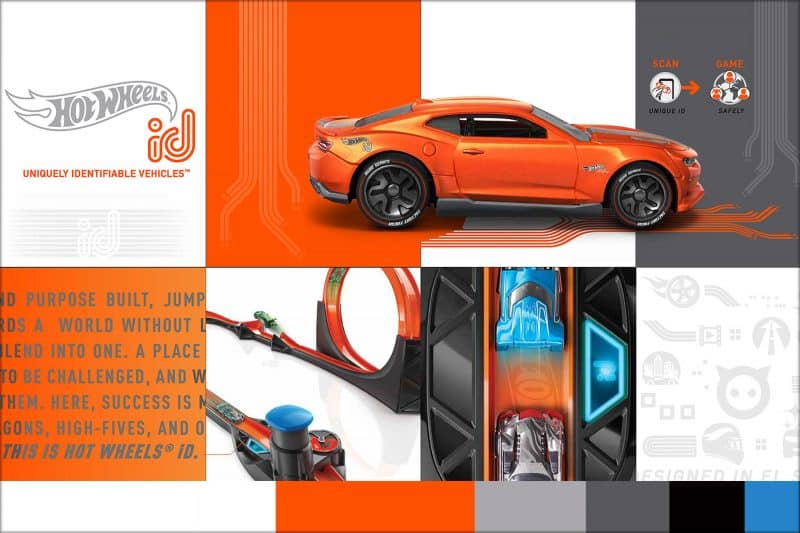
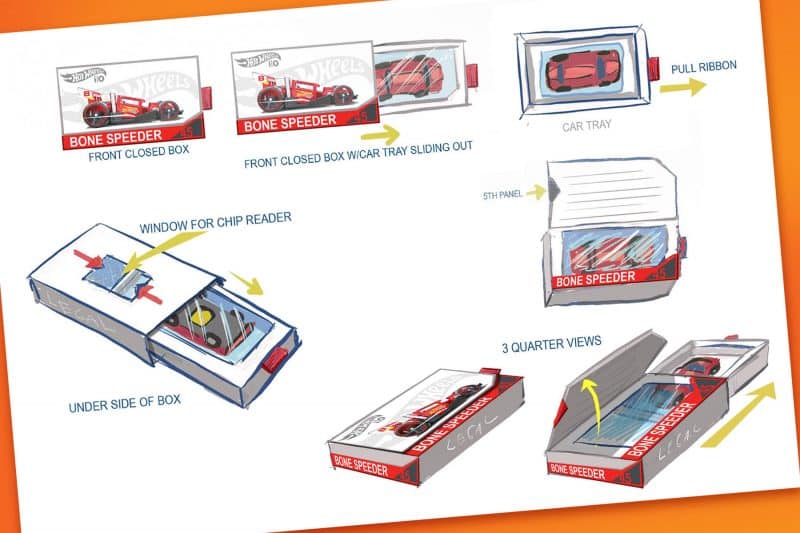
See the whole process at Joe Campos’ portfolio page for Hot Wheels id.
Hot Wheels id influencer marketing campaign / PR
Influencers were sent a Hot Wheels id crate from marketers at Mattel to build hype for the launch.
Launch Event
A launch event was held at Westfield Mall in Century City. The location was chosen because of the Apple Store in the mall. Apple was the exclusive launch partner for Hot Wheel ID.
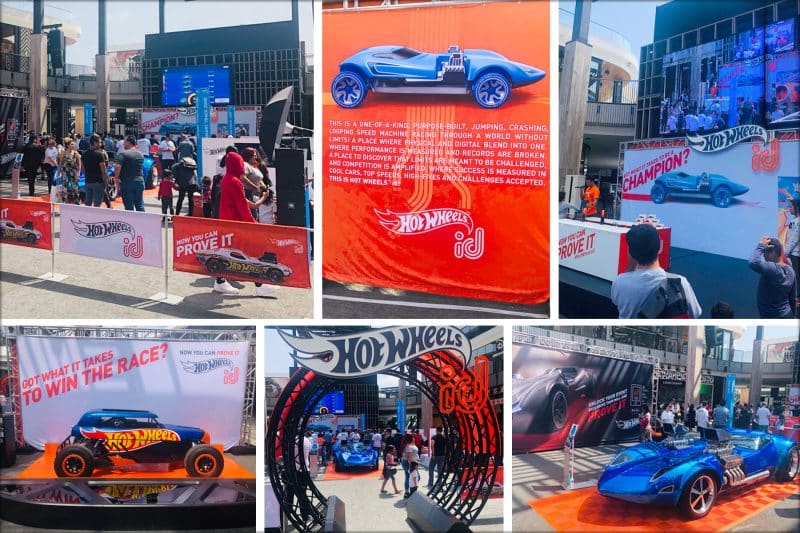
Conclusion
Understanding problems your business faces can help you design programs to curb them.
I wanted to talk about Hot Wheels id because it is a sophisticated response to a real problem that Mattel has.
This level of sophistication is rare, even in the corporate world. I witness a lot of corporate initiatives where the objectives are little more than a slide in a PowerPoint deck. Most corporate initiatives aren’t trying to solve any problem whatsoever; middle managers start an initiative simply to justify their paycheque as opposed to solving a real problem for the customer or the business.
I would like to see small businesses use a similar approach to solving problems:
- Define the problem
- Develop objectives, so you know when that problem is solved.
- Make employees and partners aware of the problem.
- Look for technology that may be useful in solving the problem.
- Brainstorm solutions to the problem
- Design a program to implement the solution
- Execute the plan
- Measure the response to your objectives to see if the problem is solved
- Double-down on the solution if it’s working, or implement a new solution if it is not working.
That may seem like a path only useful to solving large problems. But it can help you solve problems of any size. You can appropriately spend more or less time and resources on each step, and the steps could take less than a day if that made sense.
For example, one of my favorite breakfast restaurants regularly loses customers because their waiting area is small, and their queue system comprises a host writing names on a dry-erase board. It is a real business problem because profitable customers are getting fed up and leaving… and never coming back. This problem could be solved using a mix of technology and design, just as Mattel did with Hot Wheels id.
So next time you spot a problem in your business, don’t think of off-the-cuff solutions. Instead, think about what process a sophisticated business executive would use to solve it. Get the ball rolling.
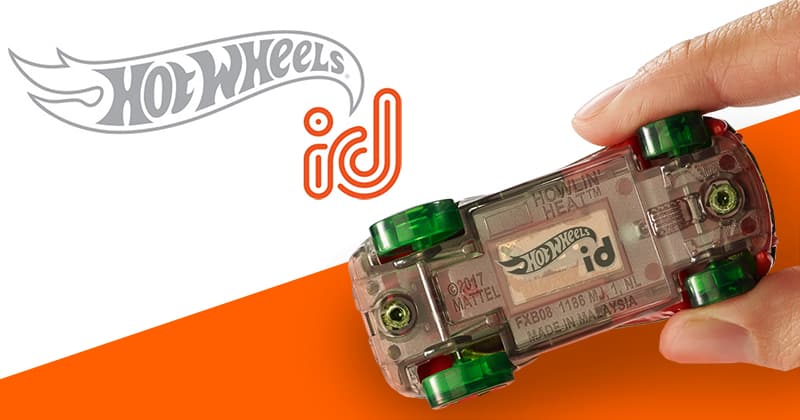
Leave a Reply to Colin Finkle Cancel reply